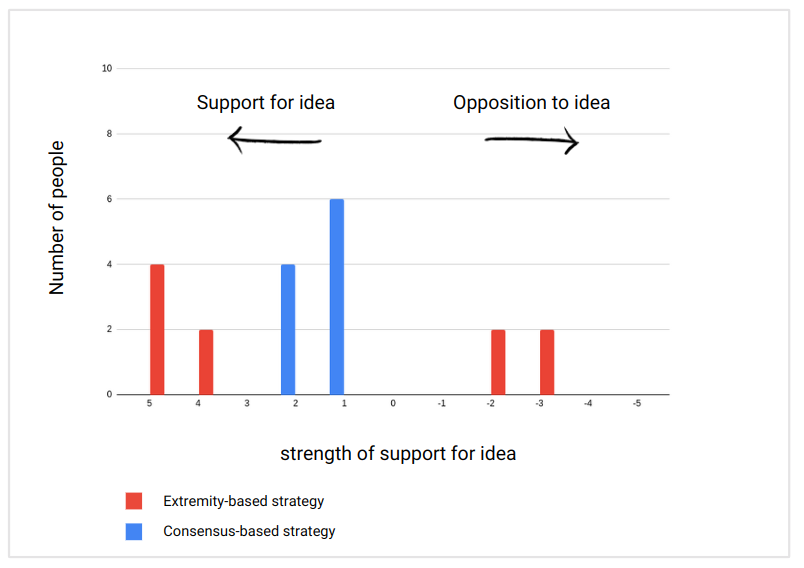
The allure of consensus
We all know that building consensus is the best way to drive change - but is it really? What if the consensus building approach is not the best way after all? Are there some cases where having a narrower but stronger support base is better? And what read across might this have for driving the sustainable transitions?
New research from the Kellogg School at Northwestern University, finds that people have a very strong preference for consensus-based persuasion strategies (broad but weak support) over extremity-based ones (narrow but strong support).
In the below chart, all 10 of the people in the blue group support the idea, whilst fewer people support the idea in the red group (6), but those supporters have stronger support for the idea on average.

A way to visual this is imagine trying to persuade a group of friends on a night out to go for a curry rather than a pizza. You could either get a low level support from the majority of people in the group to go for a curry or find a few people who say it's either curry or nothing.
Derek Rucker, a professor of marketing at the Kellogg School and leader of the study commented that “time and time again, people tend to gravitate toward getting more people on their side at the cost of having people who are true advocates.”
Why does this happen? Humans are social creatures and Rucker and his team postulate that we tend to enjoy group harmony - it feels more comfortable when a group is in general agreement than when there are strong voices on both sides of an issue. There is also a 'safety in numbers' element - even if that isn't true.
Clearly there will be occasions where a consensus based strategy is beneficial or even required (for example in a jury), but the problem that Rucker identifies is that because there seems to be an inherent preference for consensus, it can be misapplied.
To put that to the test, the researchers asked a group of participants to choose between two strategies for giving a speech to persuade a majority in a group of ten people to support an idea.
One strategy was a consensus-based one (with 8 people feeling somewhat positive and 2 feeling very positive); the other was an extremity-based strategy (with only 6 people supporting the idea, but with 5 of them feeling very positive). Note that both strategies met the objective of convincing the majority of people so either strategy would be right. However 86% chose the consensus-based approach.
To test how far the consensus would extend, they instead expressed the support of the people numerically (-5 to +5) with four different strategies, only one of which did not meet the goal of a majority in support. The other strategies had differing levels of extremity. To add a further element, half of the participants were told that a competitor giving a speech could reduce each audience member's support for the idea by 1-2 points. In other words, the strategy with the highest extremity was the one most likely to still show overall support.
In the half that didn't know about the competitor, 87.2% opted for a consensus-based strategy, but in the half that did know, two thirds of participants still chose the consensus-based strategy - even though it put them at a risk of losing!
With trying to persuade action in the sustainability transitions, we often try and go for consensus with an issue, rather than finding true advocates. However, sometimes the problem is that we are going for the wrong consensus. For example with home heating / cooling, if you try to persuade people to adopt new technologies with the promise that you would reduce their carbon emissions, you may get a varied response. However, if you instead promised it would reduce their cost to keep their homes at a comfortable temperature, I suspect, all things being equal, you would get consensus on that (and as an aside, we can reduce your carbon emissions).
And while at first only the strong advocates might buy in, over time the others will follow. You might recognise this as the S curve for innovation. Build a base among the advocates (first movers) and use that as a foundation to scale up.
We wrote about place-based approaches in this blog 👉🏾 https://www.thesustainableinvestor.org.uk/place-based-approaches-economic-and-social-value/
This article featured in What Caught Our Eye, a weekly email featuring stories we found particularly interesting during the week and why. We also give our lateral thought on each one. What Caught our Eye is available to read in full by members.
If you are not a member yet, you can read What Caught Our Eye when it comes out direct in your email inbox plus all of our blogs in full...

Click this link to register 👉🏾 https://www.thesustainableinvestor.org.uk/register/

Please read: important legal stuff.

